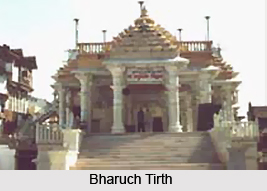 Bharuch (also known as Broach) is a district in the southern part of Gujarat. The district`s population is compared with Greater Boston. The Narmada River outlets into the Gulf of Khambat through its lands and that shipping artery gave inland access to the kingdoms and empires located in the central and northern parts of the Indian subcontinent. The city of Bharuch today serves as a large seaport city to more than a million inhabitants; it is a municipal area of Bharuch district. As a trading sea depot, the limitations of coastal shipping made it a regular terminus via several mixed trade routes of the fabled spice and silk trading between East and West, so that it came to be known by various names in history, like- Bharakuccha, Bhrigu Kaksha (the domain of Bhrigu, an ancient Indian saint), Bhroach, and of course Bhrauch. According to the 2001 census, Bharuch has a population of 148,391. It is a celebrated place for its salty peanuts.
Bharuch (also known as Broach) is a district in the southern part of Gujarat. The district`s population is compared with Greater Boston. The Narmada River outlets into the Gulf of Khambat through its lands and that shipping artery gave inland access to the kingdoms and empires located in the central and northern parts of the Indian subcontinent. The city of Bharuch today serves as a large seaport city to more than a million inhabitants; it is a municipal area of Bharuch district. As a trading sea depot, the limitations of coastal shipping made it a regular terminus via several mixed trade routes of the fabled spice and silk trading between East and West, so that it came to be known by various names in history, like- Bharakuccha, Bhrigu Kaksha (the domain of Bhrigu, an ancient Indian saint), Bhroach, and of course Bhrauch. According to the 2001 census, Bharuch has a population of 148,391. It is a celebrated place for its salty peanuts.
Bharuch Tirth, Bharuch, Gujarat: Bharuch Tirth has association with the legendary prestigious Ashvamedh yagya, is a victim of the Muslim ravaging process.
Jhagadia Tirth, Bharuch, Gujarat: The Jhagadia Tirth, with its `Moolnayak` idol, has faced replacement quite a few number of times.





















